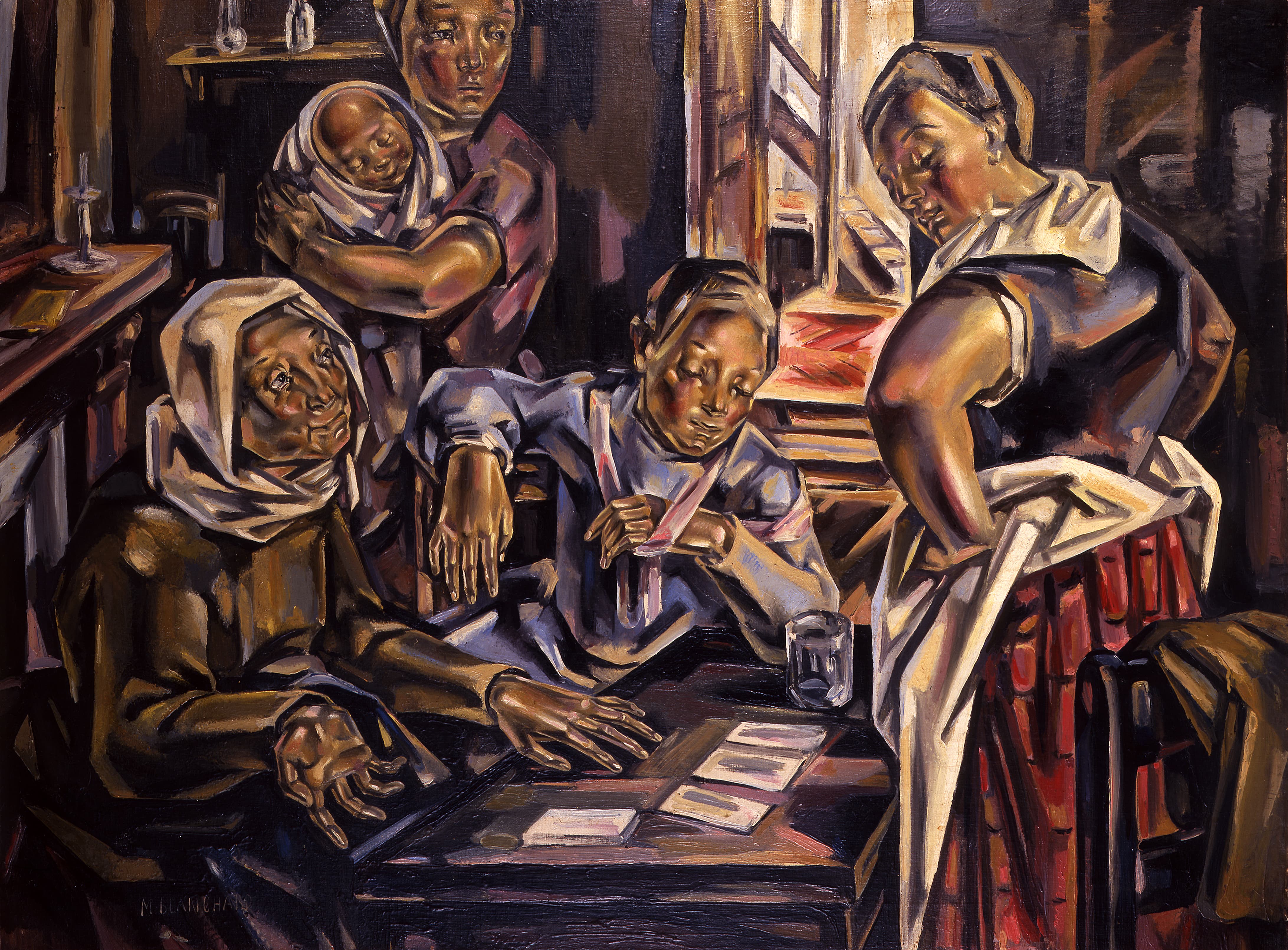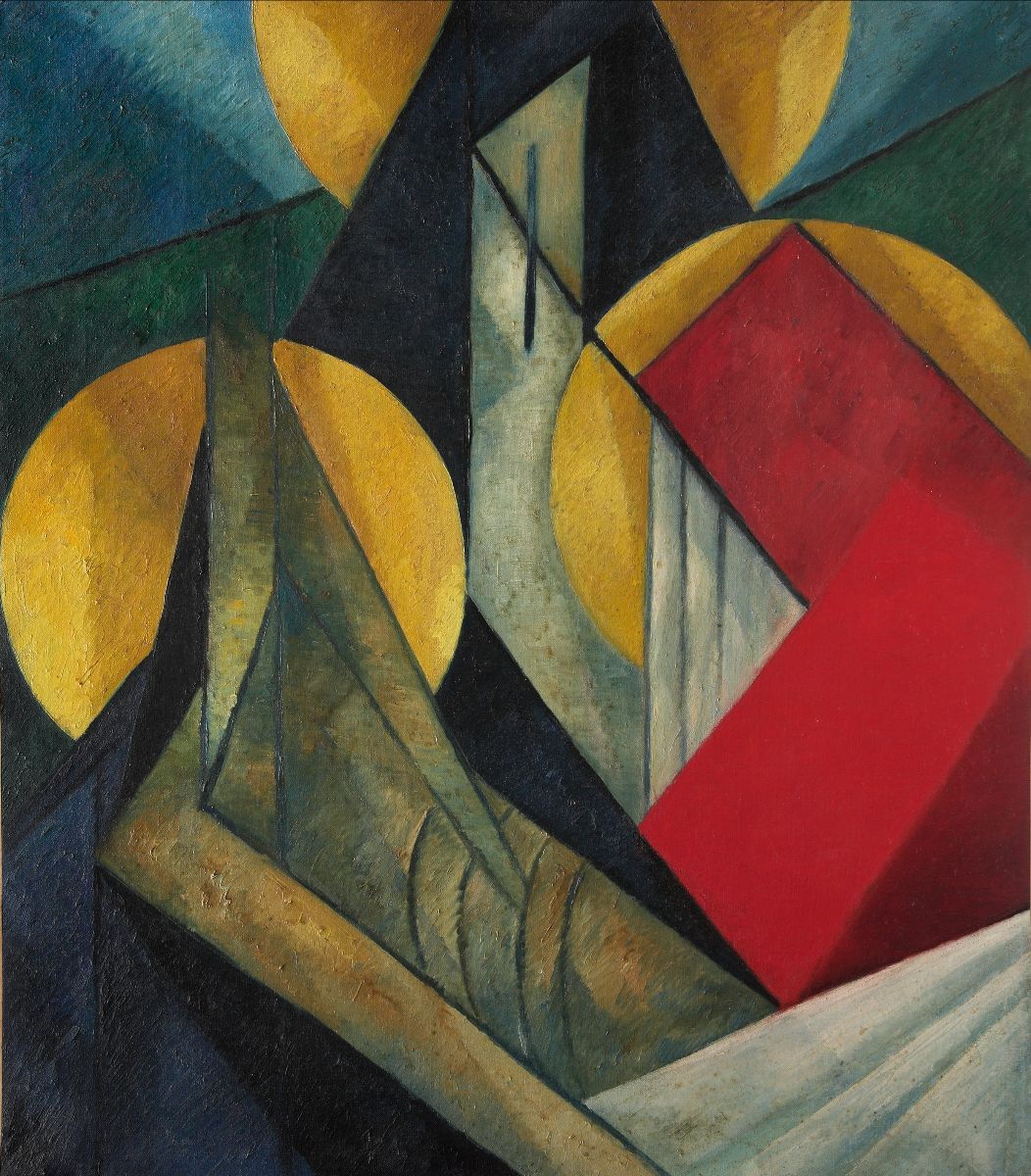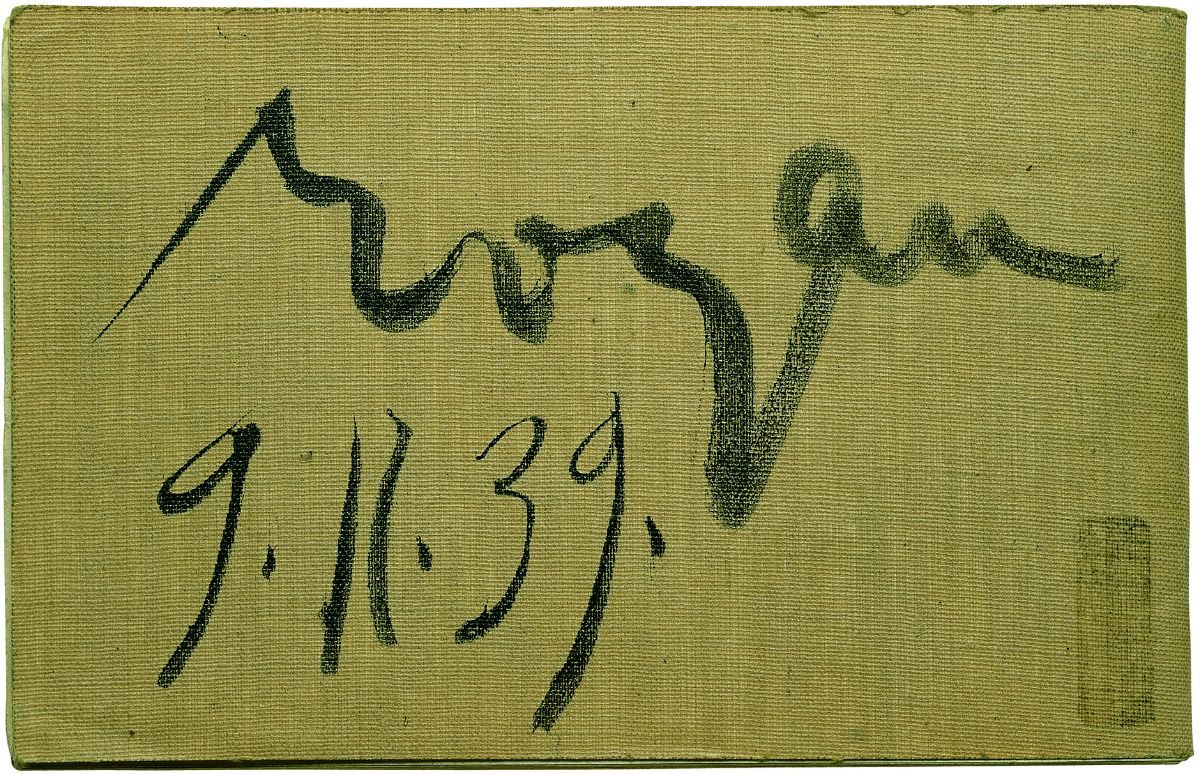
Pablo Picasso Man Seated in an Armchair. Juan-les-Pins, Summer, 1925. Oil-modified paint on canvas. 100 × 81 cm. Fundación Almine y Bernard Ruiz-Picasso, Madrid © FABA Photo: Hugard & Vanoverschelde © Succession Pablo Picasso, VEGAP, Madrid, 2024
MPM EXHIBITION PROGRAMME 2024
11/01/2024
The Museo Picasso Málaga’s 2024 exhibition programme features a new installation of the museum’s collection; a retrospective devoted to the Spanish painter María Blanchard, who was a significant member of the international modern movement; an exhibition on the caricaturist, gallerist, painter, essayist and philanthropist Marius de Zayas; and the sketchbooks which Picasso created in Royan (France) immediately after the outbreak of World War II. These four projects will be the focus of the MPM’s activities in the coming year.
On 19 March the Palacio de Buenavista’s galleries will inaugurate the seventh remodelling of the museum’s collection since it opened twenty years ago. Around 150 works by Pablo Picasso (1881-1973) will be presented with the title “Pablo Picasso: Structures of Invention. The Unity of a Life’s Work“. This new presentation aims to demonstrate the overarching unity of Picasso’s oeuvre rather than the division of his art into discrete periods or styles. Thus, until the spring of 2027 the Palacio de Buenavista’s galleries will feature paintings, sculptures, drawings, ceramics and graphic works, which will create a context that reveals new connections among Picasso’s works and challenge traditional classifications. This new display has been devised under the academic supervision of Michael FitzGerald, Kluger Family Professor of Art History at Trinity College, Hartford (USA), and in collaboration with the Fundación Almine y Bernard-Ruiz-Picasso (FABA).
Opening to the public on 30 April, “María Blanchard. Painter in spite of Cubism” is a retrospective exhibition curated by José Lebrero Stals. It complements the exhibitions organised over the past two decades by the Museo Picasso Málaga that have drawn attention to the importance of women artists’ work. The present project is a chronological survey of the different periods in the career of the painter María Blanchard (Santander, 1881-Paris1932). Blanchard was the first woman in Spain to adopt a Cubist approach and to experiment with fragmentation and multiple viewpoints in her compositions. For this reason her contribution to the modern movement is regarded as particularly notable. Combined with her level of technical mastery and the respect she earned among her contemporaries, this has made Blanchard’s work a significant point of reference.
The autumn of 2024 will see the first presentation in Spain of the caricaturist, gallerist, painter, essayist and philanthropist ”Marius de Zayas” in an exhibition to be held from 15 October 2024 to 19 January 2025 curated by José Lebrero. An “adopted son” of New York (where he introduced modern art and Picasso) and a great lover of Paris, Marius de Zayas (Veracruz, México, 1880- Stamford, Connecticut, EEUU, 1961) is a figure who is both difficult to classify but essential for the arrival of modern art in New York in the early 20th century. An outstanding caricaturist, a painter, publisher, author of essays, illustrator, journalist (the first to interview Picasso) and expert in flamenco (which he helped to popularise in Europe), de Zayas was instrumental in disseminating the work of artists including Picasso, Braque, Rodin and Cézanne.
Finally, from 3 December 2024 to 2 March 2025 the museum will host the exhibition “Pablo Picasso: the Royan Sketchbooks”, which focuses on the sketchbooks that the artist produced in the French town of Royan where he lived for a year following the outbreak of World War II. Curated by Marilyn McCully and Michael Raeburn, in collaboration with the Fundación Almine y Bernard Ruiz-Picasso (FABA), the exhibition will analyse a fertile period during which Picasso produced an important body of work. On display will be sketchbooks containing drawings and poetry, as well as numerous gouaches and paintings.
PABLO PICASSO: STRUCTURES OF INVENTION. THE UNITY OF A LIFE’S WORK
19 March 2024 to Spring 2027
For the next three years the galleries of the Museo Picasso Málaga will be showing the exhibition “Pablo Picasso: Structures of Invention. The Unity of a Life’s Work”. For the seventh time in the museum’s existence, thanks to a close collaboration between the Museo and the Fundación Almine y Bernard Ruiz-Picasso, the works on display in the galleries will be changed in order to show around 150 works of art that together reveal Picasso’s extraordinary ability to create the innovative structures that made him one of the most influential artists of the modern period.
Michael FitzGerald, Kluger Family Professor of Art History at Trinity College, Hartford, Connecticut, (USA), who is the curator of this latest transformation of the museum, has said that “Picasso’s creativity arose from two apparently opposing inspirations: innovation and retrospection”, and also that “the interplay of these two concepts defines the creative pathways that enabled him to weave together cubism, classicism, surrealism and his other innovations into the unity of a life’s work”.
Based on these insights, the new installation has been devised to involve the viewer in the artist’s creative process and to stimulate our imagination, mapping a new understanding of the work of this great master and creator. In addition, five “Focus Exhibitions,” curated by young scholars involved in the FABA Research Program, will be placed in the galleries in order to present in-depth studies of issues central to Picasso’s artistic development. These topics will range from his relationship to African sculpture (and include African works from Picasso’s own collection), to his paintings on wooden panels, his return to sculpture in plaster in the 1930s, his responses to life in Paris during World War II, and the huge mural he painted in 1957-58 for the headquarters of UNESCO in Paris.
“Pablo Picasso: Structures of Invention. The Unity of a Life’s Work “will thus reveal the coherence of the artist’s output, moving away from conventional interpretations, which have classified it by periods, by displaying works from different decades of his career alongside each other in many of the museum’s galleries. Through this combination of periods and also of techniques - painting, sculpture, ceramics, drawing and graphic art - the Museo Picasso Málaga will present connections that illustrate the ways in which the artist’s astonishing creativity was rooted in both his previous creations and his most recent innovations.
MARÍA BLANCHARD. PAINTER IN SPITE OF CUBISM
30 April to 29 September 2024
 María Blanchard (1881 - 1932) The Fortune-Teller, 1924–1925. Oil on canvas. 97 × 130 cm. Association Des Amis du Petit Palais, Geneva © Studio Monique Bernaz, Geneva
María Blanchard (1881 - 1932) The Fortune-Teller, 1924–1925. Oil on canvas. 97 × 130 cm. Association Des Amis du Petit Palais, Geneva © Studio Monique Bernaz, Geneva
This monographic exhibition organised by the Museo Picasso Málaga will present a chronological survey of the different periods in the artistic life of the painter María Blanchard (Santander, Spain, 1881-Paris, France, 1932). It will thus highlight the symbolic richness, social commitment, formal complexity and innovative nature of her work produced during her relatively short career. Blanchard’s activities were not sufficiently appreciated in her lifetime in a cultural context that espoused the inferiority of women’s artistic creation. A painter committed to her particular lifestyle and to creating to the very end, Blanchard transcended the limits of gender stereotypes.
As the first woman artist in Spain who systematically employed a Cubist approach in order to construct her images, María Blanchard contributed to the modern movement. The combination of geometrical elements and a skilful simultaneity of viewpoints give both her more abstract images from her early period and her post-Cubist figural compositions, which were produced from the period after 1920, a unique character. Blanchard’s range of subject matter - mother and child and domestic scenes, children and working women - reflect a deeply-felt female concern for the vulnerable nature of the human condition and the evocative power of emotions. She emphasised these aspects through her impeccable mastery of technique and her evident interest in the history and tradition of European painting. Curated by José Lebrero Stals, this retrospective includes approximately 90 works by the Spanish painter considered the “grande dame” of Cubism.
With this exhibition the Museo Picasso Málaga is reaffirming its commitment to highlighting the importance of 20th-century women artists, following its previous exhibitions Sophie Taeuber-Arp (2009); Hilma af Klint (2013); Louise Bourgeois (2015); We are completely free. Women artists and Surrealism (2017); and Paula Rego (2022).
MARIUS DE ZAYAS
15 October 2024 to 19 January 2025
 Marius de Zayas (1880-1961) Pietà. Rivoiranche, 1938. Oil on canvas. 78 × 68 cm. Archivo Marius de Zayas © Zayas Archives, Sevilla
Marius de Zayas (1880-1961) Pietà. Rivoiranche, 1938. Oil on canvas. 78 × 68 cm. Archivo Marius de Zayas © Zayas Archives, Sevilla
Marius de Zayas (Veracruz, México, 1880- Stamford, Connecticut, EEUU, 1961) began his professional life as a caricaturist for the two newspapers founded in Veracruz (Mexico) by his father, the esteemed poet and lawyer Rafael de Zayas. After his family moved to New York in 1907, de Zayas returned to his activities as a caricaturist, this time for the New York Evening World. His perceptive, inventive drawings attracted the attention of the photographer Alfred Stieglitz, who exhibited them in his 291 Gallery in 1909 and 1910. De Zayas went to Paris in 1910, visiting museums, galleries and, in particular, the Autumn Salon, where he discovered Cubism.
Although the modern movement initially seemed to him the “Tower of Babel of painting”, he soon changed his mind and three months later undertook an in-depth interview with Picasso, which was published in the Spanish-language magazine América. After this period of travel, de Zayas’s romantic and sophisticated style evolved towards an abstraction of bodies and faces, and over the course of fifteen years he produced drawings which alternated between caricature and avant-garde art. He was also a tireless champion of Cubist and post-Cubist art in his writings for publications such as 291 and Camera Work.
In collaboration with Stieglitz, de Zayas organised important exhibitions, including the first devoted to Picasso in the United States, held in 1911, and another on the influence of African art on European modern art in 1914. He also founded his own gallery, the Modern Gallery, in New York, which held exhibitions on Cézanne, Van Gogh, André Derain, Diego de Rivera, Juan Gris and Henri Matisse and sold their work. As an artist, journalist, collector and dealer, Marius de Zayas played a key and multifaceted role in the introduction of modern art into the United States. As iconic portraitist and caricaturist, this exhibition of his work, curated by José Lebrero, will reveal de Zayas’s largely unknown activity as a Cubist painter and visual poet, as well as his relationship with Picasso, his love of bullfighting, flamenco and Spanish folk culture, and other relevant aspects of the life of this man of great culture and humanism.
PABLO PICASSO: THE ROYAN SKETCHBOOKS
3 December 2024 to 2 March 2025
 Pablo Picasso (1881-1973) Carnet 202. Royan, November 3-9, 1939. Sketchbook with cloth cover and leaves of wove paper: 26 bound and two loose. 11 × 17 cm. Museo Picasso Málaga. Gift of Christine Ruiz-Picasso. Photo: Rafael Lobato © Museo Picasso Málaga © Succession Pablo Picasso, VEGAP, Madrid, 2024
Pablo Picasso (1881-1973) Carnet 202. Royan, November 3-9, 1939. Sketchbook with cloth cover and leaves of wove paper: 26 bound and two loose. 11 × 17 cm. Museo Picasso Málaga. Gift of Christine Ruiz-Picasso. Photo: Rafael Lobato © Museo Picasso Málaga © Succession Pablo Picasso, VEGAP, Madrid, 2024
Between September 1939 and August 1940 Picasso produced eight sketchbooks of pencil and ink drawings while he was living in the French town of Royan, where he moved with Dora Maar and accompanied by Jaime Sabartés following the outbreak of World War II. Marie-Thérèse Walter and Maya, her daughter with Picasso, were already installed in the town. Over the following year the artist travelled the 500 kilometres between Royan and Paris several times in order to make sure, as a foreigner, that his papers were in order, to check on the storage of his works, and to attend an exhibition of his drawings.
Possibly due to the difficulty of finding art materials in Royan, Picasso bought a number of sketchbooks and notepads of ordinary lined or squared paper from the Hachette bookshop. These are now the subject of this exhibition, curated by Marilyn McCully and Michael Raeburn. As was Picasso’s practice throughout his career, he used his sketchbooks for noting visual ideas, some of which referred to earlier works and others to new thoughts for future compositions.
“Pablo Picasso: the Royan Sketchbooks” organized in close collaboration with the Fundación Almine y Bernard Ruiz-Picasso, will set these sketchbooks in context by presenting them alongside related works in other media which the artist produced in Royan and documentation relating to that period. Drawings, gouaches, paintings, photographs and poems by Picasso together reveal a prolific phase in his life and artistic career.